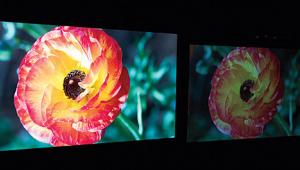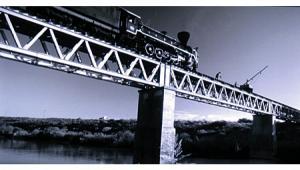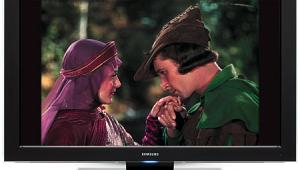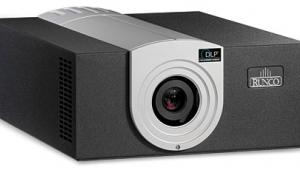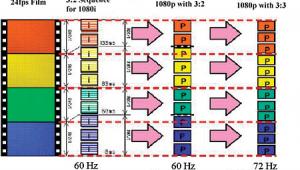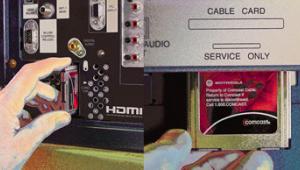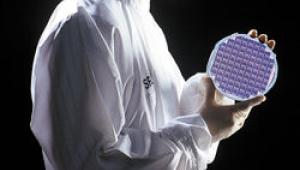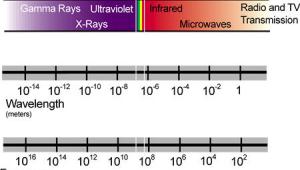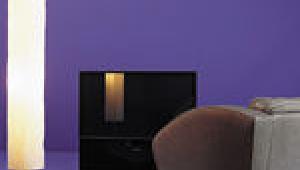You've Got TV
In the beginning, there was analog television. You aimed the antenna, tuned in the channel, and then sat back to watch as the amplitude-modulated pictures flashed on the TV screen and the frequency-modulated audio blared forth from the speakers. Some time later, analog TV added color by shoehorning in a small signal with the necessary information amongst those amplitude- and frequency-modulated pictures and sounds.
It was a simple system, but it wasn't perfect. If the signal from the TV station was weak or weather conditions were unfavorable, there might be static on the screen. If you lived in the city and used an indoor antenna, you'd often see weird ghosts of images with strange color shifts and sometimes hear a buzz through the speakers.
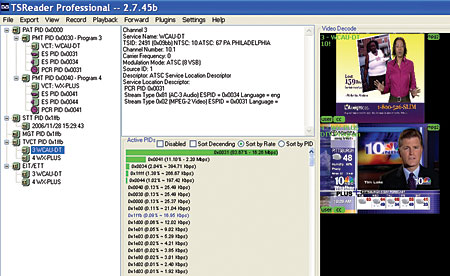
WCAU-DT transmits two channels of video (Programs 3 and 4 at left).
For better or worse, we learned to love the boob tube in its analog form for well over 50 years. But that's all changed with the advent of digital television. Gone are the problems with static, ghosts, and those weird color shifts. Gone, too, are the buzzing, humming, and noisy audio, forever banished to the 20th century.
In their place is a digital TV system that—when it is received successfully—provides crystal-clear pictures with high definition and noiseless multichannel audio. And it all happens without amplitude or frequency modulation.
So, what exactly is it that pours into the antenna or cable RF jack on your new flat-panel HDTV? You might be surprised to find out that the components of a digital TV signal have more in common with a high-speed mail-sorting facility than that old 19-inch TV in your attic.
It's All in the Packets
Imagine thousands—no, make that millions—of identically sized and colored envelopes streaming by every second on a conveyor belt. Each envelope contains a cluster of bits—bits that make up part of the video, audio, or data in a digital TV program.
To your eyes, they'd look like a blur, and any attempt on your part to sort them out would be frustrating and exhausting. If, however, you had a fast enough scanner, you could assign a unique address or identifier to each envelope—a packet ID, or PID for short—so the machine could do the sorting for you.
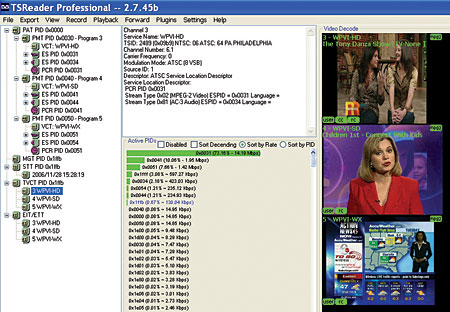
WPVI-DT's tricast carries lots of video, audio, and data packets.
That's essentially how a digital TV receiver works. It scans and grabs MPEG video, audio, and data packets as they fly by, sorts them by their unique PID addresses, tosses them into the appropriate bins, places them in the correct order, and tears open each envelope to reconstruct the contents into video, audio, and program-guide information. (Talk about going postal.)
A packet is a packet. Cable systems, direct-broadcast satellite operators, and terrestrial TV stations may use different modulation standards (QAM, VSB, QPSK) to send the packets to your home, but, once each signal is demodulated, the process is essentially the same—sort video, audio, and data packets into piles and assemble them into Dancing With the Stars or American Idol.
To anticipate your question, yes, a delay is built into such a system in case of screwups with dropped data packets. The process is known as forward error correction, and you'll see that it introduces about a 1.5-to-2-second delay between an analog TV broadcast and the digital TV version.
Check That Map
This flood of "TV mail" could easily overwhelm your integrated HDTV receiver or set-top box if it didn't have two crucial tables to use as a guide. These tables—known as the program association table (PAT) and the program map table (PMT)—are transmitted in the stream of packets and work the same way as a table of contents does in a book or a legend works on a map.
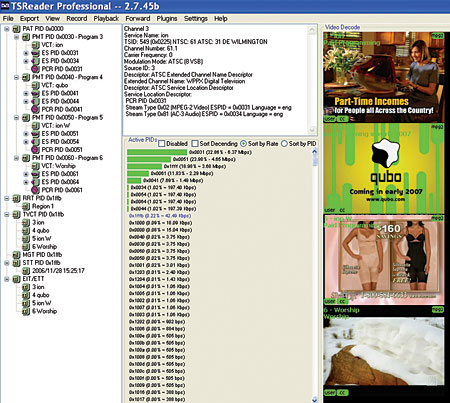
WPXN-DT stuffs four programs and tons of packets into one channel.
The PAT contains the addresses for every single PID sent out in a broadcast. (Think of a parts list.) Meanwhile, the PMT tells the receiver which PIDs to match up to make a complete TV program. (Think of assembly instructions.)
In addition to the video and audio PIDs, additional PIDs are sent along to synchronize the video and audio, provide the time and date, tell you something about the program you are watching, and identify the TV station by its virtual channel, among other functions.
That's a whole mess of data. Even so, it's all required for a digital TV program to play back correctly, as well as deliver the bells and whistles—an electronic program guide, surround audio, closed captioning—that we've come to expect from digital TV.
As you might guess, packet errors are the cause of some DTV reception problems. Early on in the DTV transition, some TV shows had video but no audio or audio with no video. It wasn't unusual to discover that a Dolby surround soundtrack had incorrect speaker assignments. Program-guide information was rare, and most of the system clock information was way out of date—sometimes off by as much as three years.
Today, most terrestrial DTV channels have stopped PID-ling around and now have their act together, although quite a few stations still don't send out much in the way of program-guide information. But we've certainly come a long way from the "aim the antenna, turn on, and hope for the best" days of analog TV.
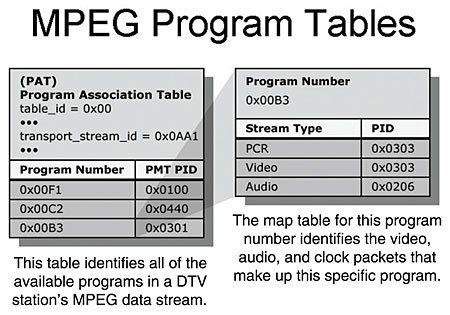
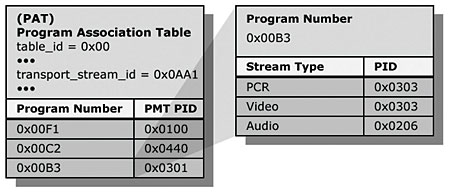
Because each video and audio program has unique PIDs, it's possible to enhance regular TV services with some simple tricks. For example, a DTV video program can easily be transmitted with two separate audio streams—one in English and one in Spanish. All it takes is the correct PID assignments in the PMT.
You could also use the same trick to send out one audio track with two different video programs (one in SD and one in HD). Multilingual electronic-program-guide content can be sent the same way—all your DTV receiver needs to know is how you've mixed and matched them.
Elementary, My Dear Watson
To see exactly how all of the data packets in a DTV program are numbered and assigned, you would need to do a little detective work with an MPEG stream analyzer. This is standalone software or a software/hardware bundle that delves into the bit stream to read those all-important PIDs.
A professional MPEG stream analyzer would have cost upward of $20,000 a decade ago. Today, you can buy software for $400 that will run on a PC and do the same job. One such program is TSReader (www.coolstf.com), which comes in three flavors, one of which can also record MPEG packets and play them back as individual programs.
I have found TSReader Pro helpful when checking a DTV station to see if it is sending out the correct virtual channel or timetable information or to find out how that station chops up the available bits to multicast two or more TV programs on the same channel. I've also seen DTV reception problems turn out to be PID problems, as the DTV station's MPEG encoder was not set up correctly.
So, as you relax in your comfy chair and enjoy the latest episode of CSI, Desperate Housewives, or Sunday Night Football in HD, pause for a moment and marvel at all of those digital envelopes flying through your HDTV set at blinding speed. (Hmm, I wonder if The Postman Always Rings Twice might be on tonight.)
- Log in or register to post comments


